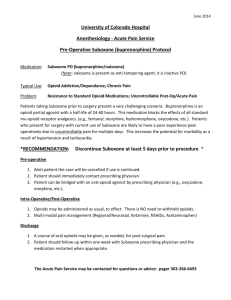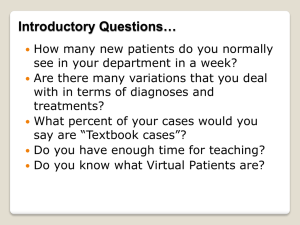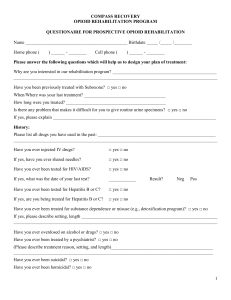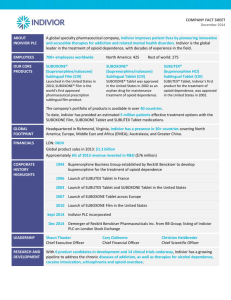Saying Goodbye to my Iowa “Dream Clinic” and 25 Suboxone
advertisement
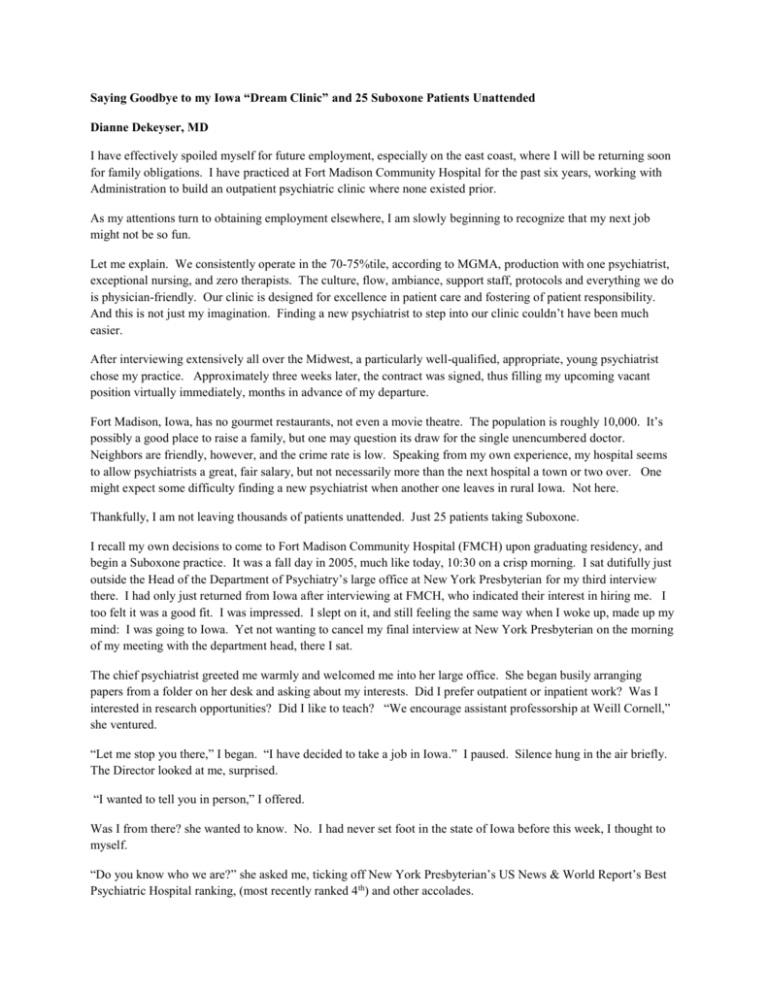
Saying Goodbye to my Iowa “Dream Clinic” and 25 Suboxone Patients Unattended Dianne Dekeyser, MD I have effectively spoiled myself for future employment, especially on the east coast, where I will be returning soon for family obligations. I have practiced at Fort Madison Community Hospital for the past six years, working with Administration to build an outpatient psychiatric clinic where none existed prior. As my attentions turn to obtaining employment elsewhere, I am slowly beginning to recognize that my next job might not be so fun. Let me explain. We consistently operate in the 70-75%tile, according to MGMA, production with one psychiatrist, exceptional nursing, and zero therapists. The culture, flow, ambiance, support staff, protocols and everything we do is physician-friendly. Our clinic is designed for excellence in patient care and fostering of patient responsibility. And this is not just my imagination. Finding a new psychiatrist to step into our clinic couldn’t have been much easier. After interviewing extensively all over the Midwest, a particularly well-qualified, appropriate, young psychiatrist chose my practice. Approximately three weeks later, the contract was signed, thus filling my upcoming vacant position virtually immediately, months in advance of my departure. Fort Madison, Iowa, has no gourmet restaurants, not even a movie theatre. The population is roughly 10,000. It’s possibly a good place to raise a family, but one may question its draw for the single unencumbered doctor. Neighbors are friendly, however, and the crime rate is low. Speaking from my own experience, my hospital seems to allow psychiatrists a great, fair salary, but not necessarily more than the next hospital a town or two over. One might expect some difficulty finding a new psychiatrist when another one leaves in rural Iowa. Not here. Thankfully, I am not leaving thousands of patients unattended. Just 25 patients taking Suboxone. I recall my own decisions to come to Fort Madison Community Hospital (FMCH) upon graduating residency, and begin a Suboxone practice. It was a fall day in 2005, much like today, 10:30 on a crisp morning. I sat dutifully just outside the Head of the Department of Psychiatry’s large office at New York Presbyterian for my third interview there. I had only just returned from Iowa after interviewing at FMCH, who indicated their interest in hiring me. I too felt it was a good fit. I was impressed. I slept on it, and still feeling the same way when I woke up, made up my mind: I was going to Iowa. Yet not wanting to cancel my final interview at New York Presbyterian on the morning of my meeting with the department head, there I sat. The chief psychiatrist greeted me warmly and welcomed me into her large office. She began busily arranging papers from a folder on her desk and asking about my interests. Did I prefer outpatient or inpatient work? Was I interested in research opportunities? Did I like to teach? “We encourage assistant professorship at Weill Cornell,” she ventured. “Let me stop you there,” I began. “I have decided to take a job in Iowa.” I paused. Silence hung in the air briefly. The Director looked at me, surprised. “I wanted to tell you in person,” I offered. Was I from there? she wanted to know. No. I had never set foot in the state of Iowa before this week, I thought to myself. “Do you know who we are?” she asked me, ticking off New York Presbyterian’s US News & World Report’s Best Psychiatric Hospital ranking, (most recently ranked 4th) and other accolades. Well, yes, I did know. My residency program is five minutes from here, I thought. I had visited their campus often, and met there for semi-private psychodynamic training with Dr. Otto Kernberg on occasion. Once, investigating opportunities for an elective during residency, I spent an afternoon in their renowned luxury inpatient unit where patients of means flew in from Europe with their own private chefs. Even then, I opted for something different. I ended up spending some elective time in a publically funded methadone clinic instead. And this, my friends, leads me to my 25 unattended patients, requiring a specialized training and DEA approval of their doctor. Now you may be asking yourselves, “If the outpatient ‘dream clinic’ you created is so wonderful, so attractive, so physician-friendly, so satisfying with good patient care, and your organization can sign on a new psychiatrist in a mere few weeks while other organizations struggle for months and years, why didn’t you get one who prescribed Suboxone?” As a matter of fact, we did. Suboxone training was one of the attributes we sought – and found -- in my replacement. However, the first year after completing training, the physician is approved for no more than 30 patients. The second year, one can request a patient limit increase to 100. I have approximately 55 patients on Suboxone. Our new psychiatrist is allowed a maximum of 30 patients… plus, of course, the thousands of other patients suffering from depression, anxiety, personality or psychosis. But here is the point: Only three of my 55 Suboxone patients live in Fort Madison. In fact, I’m told we just got a phone call this morning from someone in Nebraska looking for a doctor. Several current patients come from Iowa City and Cedar Rapids. Some have agreed that a community without specialized psychiatric care burdens the remaining healthcare, legal and social entities tremendously. Dumping a large practice off without transfer is frightening, yet happens all too often in rural America. Quite fortunately, this will not be the case in Fort Madison. Thousands of Iowans will be able to continue their specialized medication management. Thousands minus 25, that is, who need another physician to prescribe Suboxone to them. Might one of them be you? I first heard of Suboxone nine years ago in residency from a highly successful but tormented artist from New York City who found psychic relief in large quantities of heroin, self-injected daily. He managed to get to a methadone clinic before dying, and became one of my psychotherapy patients. Money, steady client referrals and some degree of international fame had come easily to him in the 1980’s, before an unfortunate (for him) turn in art trends and his journey into vodka and heroin. But even in the early 2000’s, whenever he needed more money, he was able to come downstairs from his apartment and spontaneously create paintings on the street at $300 each. Apparently this would get him though another day. Iowans on Oxycontin can also be resourceful. I often ask my opiate-dependent patients how they are able to support their habits. “You don’t want to know,” one middle-aged woman told me darkly. Another said he was a “dumpster diver” making $40,000 per year. “How is this possible?” I wondered, beginning to include delusional in my assessment. “I steal identities,” he explained, matter-of-factly. Another young man recounted just how unbelievably easy it is to steal electronics from WalMart. “I could walk in wearing a gorilla suit and walk out with a Blu-Ray under my arm and no one would notice,” he declared. Opiates are popular drugs of abuse. In the United States, one baby per hour is born in opiate withdrawal (1). About 1 in 9 youths aged 13-25 report using prescription drugs nonmedically in the past year, with opiates abused by more youths than stimulants or sedatives (2). And of hospital admissions related to benzodiazepine abuse, a clear majority of adults reported opiates , not benzodiazepines, as the primary substance of abuse. (3) We as psychiatrists cannot take on the entire world. Equally important to our responsibility and contributions to society, I believe, is taking care of ourselves. Do we feel satisfied at work? Are we making a difference in our patients’ lives? Are we truly changing lives? Suboxone treatment, in my experience, is undoubtedly the single most effective psychiatric drug I have for transforming patient lives. Granted, with a pen and a prescription pad, along with a willing participant, psychiatrists can help prevent a suicide, erase hallucinations, discover treatable medical conditions disguised as mental ones, and quell obsessions. Sometimes the medicines we choose for patients are effective, and sometimes they are not, and then we have to think harder, read more and try something else. Suboxone, though, is almost always 100% effective. Opiate-dependant Iowans who are homeless, starving and dying are now finding jobs and houses and meaningful lives when prescribed it where before they could not. I love being part of this success. It is meaningful and rewarding. I’m packing now. I’m looking at new jobs beyond, mentally preparing myself to possibly do without my favorite clinic protocols, formidable nursing staff, quality hospital culture and supportive Administration. I leave behind in southeast Iowa a successful and rewarding outpatient psychiatry clinic, a physician to take over my practice and patients, and now, an open letter of my experience treating opioid dependence to all docs still believing in the thrill of changing lives through medicine and wanting to experience it more often. Sources: (1) and (2) National Institutes of Health, National Institute on Drug Abuse; (3) SAMSHA Treatment Episode Data 2008
